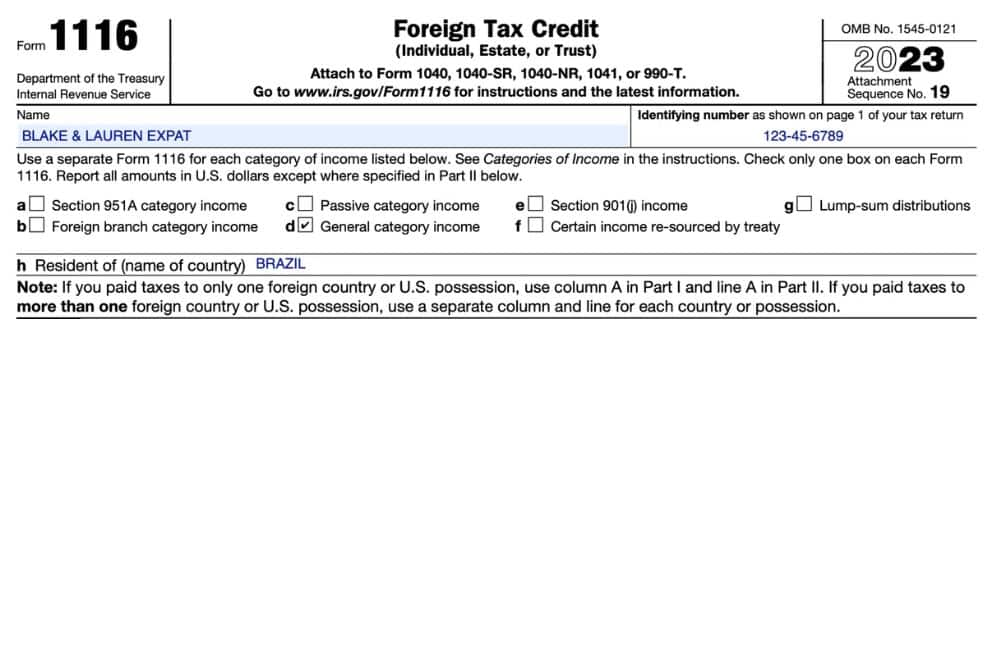Form 1116: How to Claim the Foreign Tax Credit

Form 1116, associated with the Foreign Tax Credit, is an essential IRS form designed to alleviate the financial impact of double taxation for US taxpayers with foreign income. This credit allows taxpayers to offset taxes paid in foreign countries against their US tax obligations.
Our comprehensive guide provides a detailed walkthrough on accurately completing Form 1116, ensuring you can effectively claim the maximum foreign tax credit allowable under US tax law. With step-by-step instructions, our guide simplifies the process, enabling you to understand and apply the intricacies of Form 1116 to your advantage.
By correctly filing this form, taxpayers can realize substantial savings, reducing their overall tax liability and efficiently managing their international tax responsibilities.
Key Takeaways
- US Expats can use the IRS Form 1116 to claim the Foreign Tax Credit.
- While there are rare instances that the Foreign Tax Credit is available without filing Form 1116, this form is typically a requirement.
What Is IRS Form 1116?
Form 1116 is used to claim the Foreign Tax Credit to reduce your US income tax liability, dollar for dollar for income tax paid to a foreign country. Before completing Form 1116 on your taxes, you must meet the four following criteria:
- You must have a foreign tax liability that was either paid or accrued during the current tax year
- The tax must be assessed on income
- The tax must be imposed on you as an individual and payment is mandatory
- The tax must be the legal and actual foreign tax that needs to be paid
Note that taxes that are due to be refunded to you are not included in the amount of foreign taxes paid. Before completing Form 1116, all of the foreign taxes paid will need to be converted to US dollars. The IRS prefers that each transaction be converted at the foreign exchange rate at the date of each transaction.
If the number of transactions is excessive or the exchange rate is not readily available, they will accept the annual average foreign exchange rate. To support the preparation of your US expat taxes, the IRS provides average yearly exchange rates on their website.

How to Claim the Foreign Tax Credit Using Form 1116
To claim the foreign tax credit, individuals, estates, or trusts should file Form 1116, Foreign Tax Credit, with the IRS. This form is necessary when specific foreign taxes have been paid or accrued to a foreign country or US possession. Filing Form 1116 allows taxpayers to offset their US tax liability against taxes paid to foreign governments, thereby reducing the burden of double taxation.
If you plan to use the foreign tax credit, you generally need to elect this by filing Form 1116, but there are some exceptions.
You can use the foreign tax credit without Form 1116 if the following apply:
- Your only source of foreign income for the tax year is passive income, such as interest and dividends
- Your qualified foreign taxes for the year are not more than $300 USD ($600 USD dollars if you’re filing a joint return)
- All of your gross foreign income and foreign taxes are reported to you on tax forms such as Form 1099-DIV or Form 1099-INT.
- Generally, this will only apply to people who have a very small amount of income that they’re paying foreign tax on. For instance, if you own some shares of a foreign corporation and you get a small dividend of less than $300. The IRS doesn’t require that you file Form 1116 in those cases, but you can still claim the foreign tax credit on the dividend or interest income that you earned on those assets.
Generally, this will only apply to people who have a very small amount of income that they’re paying foreign tax on. For instance, if you own some shares of a foreign corporation and you get a small dividend of less than $300. The IRS doesn’t require that you file Form 1116 in those cases, but you can still claim the foreign tax credit on the dividend or interest income that you earned on those assets.
Form 1116 Instructions
Step One: Find Out If You Qualify for the Foreign Tax Credit
To be eligible for the Foreign Tax Credit, four stipulations must be met:
- You must have incurred or paid a foreign tax liability.
- The tax must be assessed on income.
- The tax must be imposed on you as an individual.
- The tax must be the legal and actual foreign tax that needs to be paid.
Step Two: Know Your Options
You have two choices when it comes to the Foreign Tax Credit: you can deduct the taxes you’ve paid to your resident country on your Federal Tax Return, or you can fill out Form 1116 and take a credit that will reduce any amount that you owe the US, dollar for dollar. If the credited amount is more than you owe, you can carry that amount over and apply it toward any taxes you may owe in the next decade.
For US citizens who have lived abroad for extended periods, carrybacks and carryforwards of credits can be very important. If you are eligible for a foreign tax credit larger than your US expat income tax liability, then the credit can be carried back to the tax year immediately preceding the current or carried forward for the next 10 years.
This means that you can use the excess credit to try to obtain a refund from the prior year where you did not have enough credits to offset your US tax liability or choose to offset your future years’ tax liability. Schedule B of form 1116 which is part of your tax return keeps track of all foreign tax credit carryovers that can be used in the future.

Step Three: Convert Your Taxes into US Dollars
Next, you’ll need to convert the amount of taxes you paid to your resident country into US dollars using the exchange rate from the date of the transaction. If that process is too complex, you can use the annual foreign exchange rate on the IRS website.
If you accrued taxes but have not paid them, use the exchange rate from the last day of the applicable tax year.
Step Four: Identify the Limits
The amount of credit you claim on your US taxes cannot exceed the amount of US tax that you pay on that foreign-earned income. To determine the amount of the limitation, use this formula:
Foreign-sourced taxable income divided by total taxable income before exemptions, multiplied by total US tax equals foreign-sourced US tax.
Other limits apply, too. For instance, some taxes can’t be claimed, such as:
- Taxes paid on excluded income
- Taxes paid to a government that supports terrorism (as defined by the Secretary of State)
- Taxes associated with financial services income
- Dividends from each 10-50%-owned foreign corporation
- Shipping and aircraft income
- Domestic international sales corporation dividends
- Dividends from foreign sales corporations
- Foreign trade income of foreign sales corporations
- Foreign oil and gas extraction income
Don’t forget that Form 1116 (Foreign Tax Credit) cannot be used on income that has already been excluded by the Foreign Earned Income Exclusion, which is a common tax benefits expats claim.
Step Five: Complete Form 1116
At the very top of the form are some crucial instructions regarding income categories. A different Form 1116 will need to be completed for each category of income! For most expats, the general category income may suffice, as it includes wages and business income.
The second most common category is the passive category, which includes income earned from interest, dividends, rents, and similar investment income. The remaining categories aren’t often used by expats.B
Form 1116 Example
Let’s take, for example, the situation of Blake and Lauren Expat, Montana natives who moved abroad to become professional samba dancers. In 2023, Blake and Lauren had an income of $85,000 and paid taxes to the Brazilian government in the amount of Brazilian Real of 63,400. They had a $3,000 foreign tax credit carryover from 2022 and a $4,000 carryover from 2021. Additionally, Blake and Lauren had a standard deduction of $27,700.
Typically, all of their income would be excluded because of the Foreign Earned Income Exclusion, and Blake and Lauren would not have a US tax liability. However, for this example, we will assume that Blake and Lauren have not yet claimed the Foreign Earned Income Exclusion and will only be claiming the foreign tax credit.
When claiming the foreign tax credit on Form 1116, taxpayers are required to categorize the income earned by the taxpayer. A separate Form 1116 will need to be completed for each category of income. Luckily, Blake and Lauren only have income attributable to the General Income category (basic wage, salary, and business income). For information regarding the other categories, please contact one of our US expat tax experts.
The information portion of Blake and Lauren’s Form 1116 will be completed as follows:

Form 1116: Part I
Next, Blake and Lauren will complete Part I. This information asks the taxpayer to explain all of the income from sources outside the US.
Blake and Lauren only had income from Brazil, in the amount of $65,000 USD. As US citizens, Blake and Lauren are required to report and pay taxes on this income to the US. However, they are still eligible for itemized or standard deductions, which they have used to offset their income. Before calculating their foreign tax credit, these amounts will need to be considered on their Form 1116. Part I will be completed as follows:

Form 1116: Part II
Part II of Form 1116 asks the taxpayer to report the amount of taxes that were paid or accrued by the taxpayer in the current tax year. Please note that this section also asks for foreign taxes paid to be reported in the foreign currency amount and the US dollar amount.
In Brazilian currency, the amount of foreign taxes that Blake and Lauren paid was 63,400R$. This has been converted at the FX rate of 0.2011. (63,400 x 0.20 = $12,750). When reporting this information, the IRS also requests that the taxpayer add a statement to the tax return that includes the foreign currency conversion rate.

Form 1116: Part III
Part III of Form 1116 computes the amount of credit eligible to be claimed on the taxpayer’s US tax return. With an earned income of $85,000 and claiming a standard deduction of $27,700, Blake and Lauren had a US tax liability of $6,876. Each line of Part III is essentially calculations, and the instructions associated with each line on the form will walk the taxpayer through its completion.
The foreign tax credit for which Blake and Lauren are eligible will completely wipe out their US expat tax liability, and they never even had to complete the much more complex Form 2555! Nor did they have to tap into their prior year’s foreign tax credit carryovers.

Blake and Lauren paid $12,750 in total foreign taxes during 2023. However, because their US tax liability was only $6,876 after their standard/itemized deductions, they could only use $6,876 of the total $12,750. Thus, they will be eligible to carry $5,874 of the 2023 foreign tax credit over into future tax years!
Form 1116: Part IV
The last portion of Form 1116 asks the taxpayer to summarize the foreign tax credits claimed on other Forms 1116 for the current tax year. Because Blake and Lauren only had income from the “General” category, they will only need to include this one form, and Part IV of Form 1116 will be completed as follows:

Let Greenback Take Care of Your Form 1116
The IRS does require US citizens and resident aliens to report and pay taxes on their worldwide come, but there are many ways to reduce double taxation, including the Foreign Tax Credit. Although this article offers a simple example of how to file Form 1116 for the Foreign Tax Credit, it may be more complicated for expatriates who need to file US taxes.
Contact us, and one of our customer champions will be happy to help. If you need very specific advice on your specific tax situation, you can also click below to get a consultation with one of our expat tax experts.



